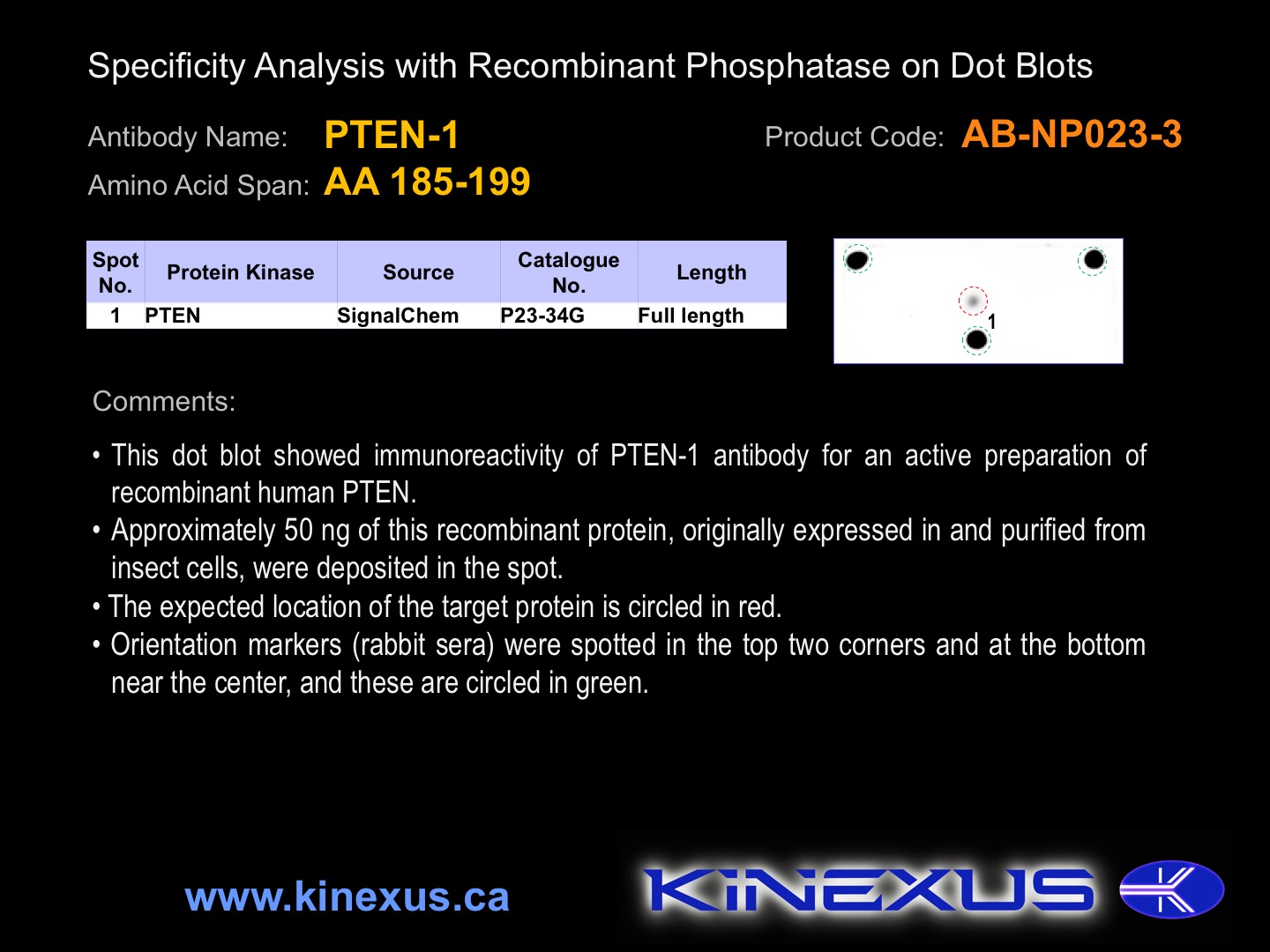Product Name: PTEN-1
Product Number: AB-NP023-3
| Size: | 25 µg | Price: | 89.00 | |
| $US |
Target Full Name: Phosphatidylinositol-3,4,5-trisphosphate 3-phosphatase and protein phosphatase and tensin homolog deleted on chromosome 10
Target Alias: BZS; MHAM; MMAC1; Mutated in multiple advanced cancers 1; Phosphatase and tensin; Phosphatase and tensin homolog gene; Protein-tyrosine phosphatase PTEN; PTEN1; TEP1
Product Type Specific: PTEN pan-specific antibody
Antibody Code: NP023-3
Antibody Target Type: Pan-specific
Protein UniProt: P60484
Protein SigNET: P60484
Antibody Type: Polyclonal
Antibody Host Species: Rabbit
Target Alias: BZS; MHAM; MMAC1; Mutated in multiple advanced cancers 1; Phosphatase and tensin; Phosphatase and tensin homolog gene; Protein-tyrosine phosphatase PTEN; PTEN1; TEP1
Product Type Specific: PTEN pan-specific antibody
Antibody Code: NP023-3
Antibody Target Type: Pan-specific
Protein UniProt: P60484
Protein SigNET: P60484
Antibody Type: Polyclonal
Antibody Host Species: Rabbit
Antibody Immunogen Source: Human PTEN sequence peptide Cat. No.: PE-01BBM99
Antibody Immunogen Sequence: CHLDYRPVALLFHKMM
Antibody Immunogen Description: Corresponds to amino acid residues H185 to M199
Production Method: The immunizing peptide was produced by solid phase synthesis on a multipep peptide synthesizer and purified by reverse-phase hplc chromatography. Purity was assessed by analytical hplc and the amino acid sequence confirmed by mass spectrometry analysis. This peptide was coupled to KLH prior to immunization into rabbits. New Zealand White rabbits were subcutaneously injected with KLH-coupled immunizing peptide every 4 weeks for 4 months. The sera from these animals was applied onto an agarose column to which the immunogen peptide was thio-linked. Antibody was eluted from the column with 0.1 M glycine, pH 2.5. Subsequently, the antibody solution was neutralized to pH 7.0 with saturated Tris.
Antibody Immunogen Sequence: CHLDYRPVALLFHKMM
Antibody Immunogen Description: Corresponds to amino acid residues H185 to M199
Production Method: The immunizing peptide was produced by solid phase synthesis on a multipep peptide synthesizer and purified by reverse-phase hplc chromatography. Purity was assessed by analytical hplc and the amino acid sequence confirmed by mass spectrometry analysis. This peptide was coupled to KLH prior to immunization into rabbits. New Zealand White rabbits were subcutaneously injected with KLH-coupled immunizing peptide every 4 weeks for 4 months. The sera from these animals was applied onto an agarose column to which the immunogen peptide was thio-linked. Antibody was eluted from the column with 0.1 M glycine, pH 2.5. Subsequently, the antibody solution was neutralized to pH 7.0 with saturated Tris.
Antibody Modification: Unconjugated. Contact KInexus if you are interest in having the antibody biotinylated or coupled with fluorescent dyes.
Antibody Concentration: 1 mg/ml
Storage Buffer: Phosphate buffered saline pH 7.4, 0.05% Thimerasol
Storage Conditions: For long term storage, keep frozen at -40°C or lower. Stock solution can be kept at +4°C for more than 3 months. Avoid repeated freeze-thaw cycles.
Product Use: Western blotting | Antibody microarray
Antibody Dilution Recommended: 2 µg/ml for immunoblotting
Antibody Species Reactivity: Human
Antibody Concentration: 1 mg/ml
Storage Buffer: Phosphate buffered saline pH 7.4, 0.05% Thimerasol
Storage Conditions: For long term storage, keep frozen at -40°C or lower. Stock solution can be kept at +4°C for more than 3 months. Avoid repeated freeze-thaw cycles.
Product Use: Western blotting | Antibody microarray
Antibody Dilution Recommended: 2 µg/ml for immunoblotting
Antibody Species Reactivity: Human
Antibody Positive Control: The observed molecular mass of the processed target protein on SDS-PAGE gels is reported to be around 52-58 kDa.
Antibody Specificity: Very high
Related Product 1: PTEN-1 blocking peptide
Related Product 2: PTEN-2 pan-specific antibody (Cat. No.: AB-NP023-4)
Related Product 3: PTEN-3 pan-specific antibody (Cat. No.: AB-NP023-5)
Antibody Specificity: Very high
Related Product 1: PTEN-1 blocking peptide
Related Product 2: PTEN-2 pan-specific antibody (Cat. No.: AB-NP023-4)
Related Product 3: PTEN-3 pan-specific antibody (Cat. No.: AB-NP023-5)
Scientific Background: PTEN is a dual-specificity protein phosphatase, dephosphorylating tyrosine-, serine- and threonine-phosphorylated proteins, and also acts as a lipid phosphatase, removing the phosphate in the D3 position of the inositol ring from phosphatidylinositol 3,4,5-trisphosphate, phosphatidylinositol 3,4-diphosphate, phosphatidylinositol 3-phosphate and inositol 1,3,4,5-tetrakisphosphate with order of substrate preference in vitro PtdIns(3,4,5)P3 > PtdIns(3,4)P2 > PtdIns3P > Ins(1,3,4,5)P4. The lipid phosphatase activity is critical for the tumor suppressor function of PTEN. It antagonizes the PI3K-AKT/PKB signalling pathway by dephosphorylating phosphoinositides, and inhibits cell cycle progression and cell survival. The unphosphorylated form of PTEN cooperates with AIP1 to suppress Akt1 activation. It dephosphorylates tyrosine-phosphorylated focal adhesion kinase (FAK) and inhibits cell migration and integrin-mediated cell spreading and focal adhesion formation. It plays a role as a key modulator of the AKT-mTOR signalling pathway controlling the tempo of the process of newborn neurons integration during adult neurogenesis. It acts as negative regulator of insulin signalling and glucose metabolism in adipose tissue. The nuclear monoubiquitinated form possesses greater apoptotic potential, whereas the cytoplasmic nonubiquitinated form induces less tumor suppressive ability. In motile cells, PTEN suppresses the formation of lateral pseudopods and thereby promotes cell polarization and directed movement.
© Kinexus Bioinformatics Corporation 2017


